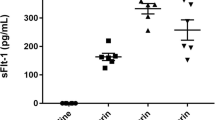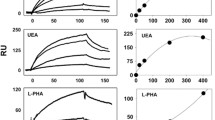Abstract
Vascular endothelial growth factor (VEGF) is a specific angiogenic factor, and thrombospondin (TSP), is a potent inhibitor of angiogenesis. To better understand the role of TSP as an anti-angiogenic agent, we have identified its specific domains that participate in its anti-angiogenic activity and examined the mechanism of its inhibitory effect on VEGF165 induced angiogenesis. Exogenously added TSP inhibited VEGF165 induced angiogenesis (proliferation and tube formation of human dermal microvascular endothelial cells {HDMEC} and neovascular outgrowth from human arterial rings). Although both VEGF165 and TSP are heparin binding proteins, TSP had a higher affinity for 125I-heparin than VEGF165 (K d1 4 nM and K d2 14 nM for TSP; K d 91 nM for VEGF165). TSP displaced 36% of 125I-VEGF165 from HDMEC and this was comparable to the 27% reduction in 125I-VEGF165 binding to HDMEC upon cleavage of cell surface heparan sulfate (HS). About 35% of the mitogenic activity of VEGF165 was attributable to its heparin binding region. These results indicate that a proportion of the mitogenic activity of VEGF165 is inhibited by TSP via competition for cell surface HS. Further, 125I-VEGF165 bound directly to TSP in a saturable, concentration dependent manner, and heparin modulated this binding. The mAbs to the heparin binding domain to the type 1 and type 3 repeats of TSP inhibited the binding of VEGF165 to TSP, and also blocked the inhibitory effect of TSP on VEGF165 induced HDMEC proliferation. We conclude that (i) the anti-angiogenic activity of TSP is localized in its heparin binding domain and type 1 and type 3 repeats (ii) TSP inhibits angiogenesis by at least two separate mechanisms, (a) displacement of VEGF165 from endothelial cell HS and (b) direct binding to VEGF165.
Similar content being viewed by others
References
Folkman J. The role of angiogenesis in tumor growth. Semin Cancer Biol 1992; 3: 65–71.
Ferrara N, Houck K, Jakeman L, Leung DW. Molecular and biological properties of the vascular endothelial cell growth factor family of proteins. Endocr Rev 1992; 13: 18–32.
Ferrara N. The role of vascular endothelial growth factor in pathological angiogenesis. Breast Cancer Res Treatment 1995; 36: 127–37.
Carmeliet P, Ferrara N, Breier G et al. Abnormal blood vessel development and lethality in embryos lacking a single VEGF allele. Nature 1996; 380: 435–9.
Klagsbrun M, D'Amore PA. Vascular endothelial growth factor and its receptors. Cytokine Growth Factor Rev 1996; 7: 259–70.
Houck KA, Leung DW, Rowland AM et al. Dual regulation of vascular endothelial growth factor bioavailability by genetic and proteolytic mechanisms. J Biol Chem 1992; 267: 26031–7.
Park JE, Keller GA, Ferrara N. The vascular endothelial growth factor (VEGF) isoforms: Differential deposition into the subepithelial extracellular matrix and bioactivity of ECM-bound VEGF. Mol Biol Cell 1993; 4: 1317–26.
Hanahan D, Folkman J. Patterns and emerging mechanisms of the angiogenic switch during tumorigenesis. Cell 1996; 86: 353–64.
Good DJ, Polverini PJ, Rastinejad F et al. A tumor suppressor-dependent inhibitor of angiogenesis is biologically and functionally indistinguishable from a fragment of thrombospondin. Proc Natl Acad Sci USA 1990; 87: 6624–8.
Iruela-Arispe ML, Bornstein P, Sage H. Thrombospondin exerts an antiangiogenic effect on cord formation by endothelial cells in vitro. Proc Natl Acad Sci USA 1991; 88: 5026–30.
Dameron KM, Volpert OV, Tainsky MA, Bouck N. Control of angiogenesis in fibroblasts by p53 regulation of thrombospondin-1. Science 1994; 265: 1582–84.
Weinstat-Saslow DL, Zabrenetzky VS, VanHoutte K et al. Transfection of thrombospondin 1 complementary DNA into a human breast carcinoma cell line reduces primary tumor growth, metastatic potential, and angiogenesis. Cancer Res 1994; 54: 6504–11.
Battegay EJ. Angiogenesis: mechanistic insights, neovascular diseases, and therapeutic prospects. J Mol Med 1995; 73: 333–46.
Roberts DD. Regulation of tumor growth and metastasis by thrombospondin-1. FASEB J 1996; 10: 1183–91.
Dawson DW, Volpert OV, Pearce SF et al. Three distinct D-amino acid substitutions confer potent antiangiogenic activity on an inactive peptide derived from a thrombospondin-1 type 1 repeat. Mol Pharmacol 1999; 55: 332–8.
Adams JC, Tucker RP, Lawler J. The Thrombospondin Gene Family. New York: Springer-Verlag 1995; 1–9.
Gupta K, Gupta P, Solovey A, Hebbel RP. Mechanism of interaction of thrombospondin with human endothelium and inhibition of sickle erythrocyte adhesion to human endothelial cells by heparin. Biochim Biophys Acta 1999; 1453: 63–73.
Benezra D, Griffin BW, Maftzir G, Aharonov O. Thrombospondin and in vivo angiogenesis induced by basic fibroblast growth factor or lipopolysaccharide. Invest Ophthalmol Vis Sci 1993; 34: 3601–8.
Tuszynski GP, Nicosia RF. The role of thrombospondin-1 in tumor progression and angiogenesis. BioEssays 1996; 18: 71–6.
Bagavandoss P, Wilks JW. Specific inhibition of endothelial cell proliferation by thrombospondin. Biochem Biophys Res Commun 1990; 170: 867–72.
Taraboletti G, Roberts D, Liotta LA, Giavazzi R. Platelet thrombospondin modulates endothelial cell adhesion, motility, and growth: A potential angiogenesis regulatory factor. J Cell Biol 1990; 111: 765–72.
Vogel T, Guo N-H, Krutzsch HC et al. Modulation of endothelial cell proliferation, adhesion, and motility by recombinant heparin-binding domain and synthetic peptides from the Type I repeats of thrombospondin. J Cell Biol 1993; 53: 74–84.
Taraboletti G, Belotti D, Borsotti P et al. The 140-kilodalton antiangiogenic fragment of thrombospondin-1 binds to basic fibroblast growth factor. Cell Growth & Differentiation 1997; 8: 471–9.
Tolsma SS, Stack MS, Bouck N. Lumen formation and other angiogenic activities of cultured capillary endothelial cells are inhibited by thrombospondin-1. Microvasc Res 1997; 54: 13–26.
Leung DW, Cachianes G, Kuang W-J, Goeddel DV et al. Vascular endothelial growth factor is a secreted angiogenic mitogen. Science 1989; 246: 1306–9.
Detmar M, Yeo K-T, Nagy JA et al. Keratinocyte-derived vascular permeability factor (vascular endothelial growth factor) is a potent mitogen for dermal microvascular endothelial cells. J Invest Dermatol 1995; 105: 44–50.
Gupta K, Ramakrishnan S, Browne PV et al. A novel technique for culture of human dermal microvascular endothelial cells under either serum-free or serum-supplemented conditions: Isolation by panning and stimulation with vascular endothelial growth factor. Exp Cell Res 1997; 230: 244–51.
Tolsma SS, Volpert OV, Good DJ et al. Peptides derived from two separate domains of the matrix protein thrombospondin-1 have anti-angiogenic activity. J Cell Biol 1993; 122: 497–511.
Bornstein P. Diversity of function is inherent in matricellular proteins: An appraisal of thrombospondin 1. J Cell Biol 1995; 130: 503–6.
Hogg PJ. Thrombospondin-1 as an enzyme inhibitor. Thromb Haemost 1994; 72: 787–92.
Schultz-Cherry S, Ribeiro S, Gentry L, Murphy-Ullrich JE. Thrombospondin causes activation of latent transforming growth factor-beta secreted by endothelial cells by a novel mechanism. J Biol Chem 1994; 269: 26775–82.
Lamzus K, Joseph A, Jin L et al. Scatter factor binds to TSP and other extracellular matrix components. Am J Pathol 1996; 149: 805–19.
Mohanraj D, Olson T, Ramakrishnan S. Expression of biologically active human vascular endothelial growth factor. Growth Factors 1995; 12: 17–27.
Mohanraj D, Olson T, Ramakrishnan S. A novel method to purify recombinant vascular endothelial growth factor (VEGF121) expressed in yeast. Biochem Biophys Res Commun 1995; 215: 750–6.
Enenstein JE, Gupta K, Vercellotti GM, Hebbel RP. Thrombin-stimulated calcium mobilization is inhibited by thrombospondin via CD36. Exp Cell Res 1998; 38: 465–71.
Nicosia RF, Ottinetti A. Growth of microvessels in serum-free matrix culture of rat aorta. A quantitative assay of angiogenesis in vitro. Lab Invest 1990; 63: 115–22.
Gupta P, Oegema TR Jr., Brazil JJ et al. Structurally specific heparan sulfates support primitive human hematopoiesis by formation of a multimolecular stem cell niche. Blood 1998; 92: 4641–51.
Lee MK, Lander AD. Analysis of affinity and structural selectivity in the binding of proteins to glycosaminoglycans: Development of a sensitive electrophoretic approach. Proc Natl Acad Sci USA 1991; 88: 2768–72.
Gitay-Goren H, Soker S, Vlodavsky I, Neufeld G. The binding of vascular endothelial growth factor to its receptors is dependent on cell surface-associated heparin-like molecules. J Biol Chem 1992; 267: 6093–6.
Tessler S, Rockwell P, Hicklin D et al. Heparin modulates the interaction of VEGF165 with soluble and cell associated flk-1 receptors. J Biol Chem 1994; 269: 12456–61.
Murphy-Ullrich JE, Mosher DF. Interactions of thrombospondin with endothelial cells: Receptor-mediated binding and degradation. J Cell Biol 1987; 105: 1603–11.
Suzuma K, Takagi H, Otani A et al. Expression of thrombospondin-1 in ischemia-induced retinal neovascularization. Am J Pathol 1999; 154: 343–54.
Dawes J, Clemetson KJ, Gogstad GO et al. A radioimmunoassay for thrombospondin, used in a study of thrombospondin, beta-thromboglobulin and platelet factor 4 in healthy volunteers. Thrombosis Res 1983; 29: 569–81.
Keyt BA, Berleau LT, Nguyen HV et al. The carboxyl-terminal domain (111–165) of vascular endothelial growth factor is critical for its mitogenic potency. J Biol Chem 1996; 271: 7788–95.
Soker S, Gollamudi-Payne S, Fidder H et al. Inhibition of vascular endothelial growth factor (VEGF)-induced endothelial cell proliferation by a peptide corresponding to the exon 7-encoded domain of VEGF165. J Biol Chem 1998; 272: 31582–8.
Gengrinovitch S, Greenberg SM, Cohen T et al. Platelet factor-4 inhibits the mitogenic activity of VEGF121 and VEGF165 using several concurrent mechanisms. J Biol Chem 1995; 270: 15059–65.
Suchard SJ, Mansfield PJ. Neutrophil thrombospondin receptors are linked to GTP-binding proteins. J Cell Physiol 1996; 168: 217–27.
Gao A-G, Lindberg FP, Finn MB et al. Integrin-associated protein is a receptor for the C-terminal domain of thrombospondin. J Biol Chem 1996; 271: 21–4.
Chung J, Gao A-G, Frazier WA. TSP acts via IAP to activate the platelet integrin αIIbβ3. J Biol Chem 1997; 272: 14740–6.
Roberts DD, Haverstick DM, Dixit VM et al. The platelet glycoprotein thrombospondin binds specifically to sulfated glycolipids. J Biol Chem 1988; 260: 9405–11.
Lawler J, Weinstein R, Hynes RO. Cell attachment to thrombospondin: the role of ARG-GLY-ASP, calcium, and integrin receptors. J Cell Biol 1988; 107: 2351–61.
Asch AS, Silbiger S, Heimer E, Nachman RL. Thrombospondin sequence motif (CSVTCG) is responsible for CD36 binding. Biochem Biophys Res Commun 1992; 182: 1208–17.
Brooks PC, Montgomery AM, Rosenfeld M et al. Integrin α v β 3 antagonists promote tumor regression by inducing apoptosis of angiogenic blood vessels. Cell 1994; 79: 1157–64.
Dawson DW, Pearce SFA, Zhong R et al. CD36 mediates the in vitro inhibitory effects of thrombospondin-1 on endothelial cells. J Cell Biol 1997; 138: 707–17.
Krufka A, Guimond S, Rapraeger AC. Two heirarchies of FGF-2 signaling in heparin: Mitogenic stimulation and high-affinity binding/receptor transphosphorylation. Biochem 1996; 35: 11131–41.
Author information
Authors and Affiliations
Rights and permissions
About this article
Cite this article
Gupta, K., Gupta, P., Wild, R. et al. Binding and displacement of vascular endothelial growth factor (VEGF) by thrombospondin: Effect on human microvascular endothelial cell proliferation and angiogenesis. Angiogenesis 3, 147–158 (1999). https://doi.org/10.1023/A:1009018702832
Issue Date:
DOI: https://doi.org/10.1023/A:1009018702832




